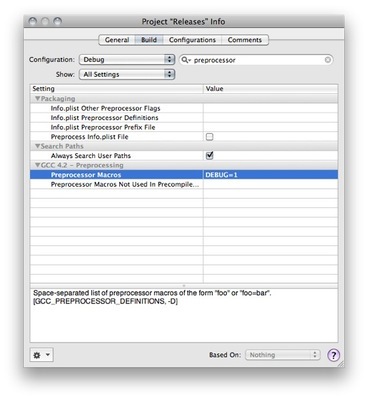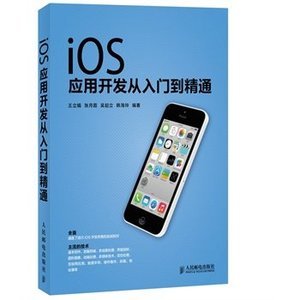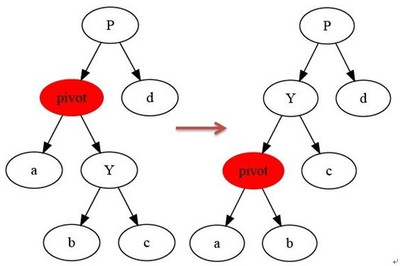(一).关于nil
http://cocoadevcentral.com/d/learn_objectivec/
Calling Methods on Nil
In Objective-C, thenilobject isthe functional equivalent to theNULLpointer in many otherlanguages.
The difference is that you can call methods on nil without crashingor throwing anexception.
在Objective-C中,nil对象与许多其他语言中的NULL指针有同样的功能。
区别在于,你可以向一个nil对象发送任何信息,即让一个nil的对象调用任何方法,而不会导致程序的崩溃或者抛出异常。
这是一个有用的基础知识
另外在cocoachina (http://www.cocoachina.com/bbs/read.php?tid-70288.html)论坛有人指出
对象被release后系统会将该块内存标记为可用(可重新分配)nil就是起到个重置指针的作用对内存的释放无意义
防止出现调用错误。
(二).结论:
不同的环境下使用不同的代码处理是中庸之道,也就是
如果你在开发和调试,测试阶段
使用可以直接暴露问题代码的dealloc处理方式:
在dealloc中即仅仅release你的变量。
如果你把程序发布给用户使用,使用先release,后赋值nil的方式
这样,不会暴露crash给用户
(三)..以下是参考:
首先,这是一篇非常好的博客,详细说明了关于dealloc中的几种处理方式的论证
http://iphonedevelopment.blogspot.com/2010/09/dealloc.html
英文好的看原文,不要被我的翻译误解。
另外:
stackoverflow上几个有价值的参考,上面讨论了开发者的在这方面的经验:
http://stackoverflow.com/questions/4124049/dealloc-use-release-or-set-to-nil-for-properties
http://stackoverflow.com/questions/192721/why-shouldnt-i-use-objective-c-2-0-accessors-in-init-dealloc
(四)..现在,正式对这篇博客翻译:http://iphonedevelopment.blogspot.com/2010/09/dealloc.html
声明:如果有错误翻译或者错字等请指出,但是本人仅是翻译供学习探讨所用,任何问题与纠纷居于本人无关,谢谢合作!
Dealloc
Last week there was a bit of a Twitter in-fight in the iOScommunity over the "right" way to release your instance variablesindealloc.I think Robactually started it, to behonest, but I probably shouldn't be bringing that up.
上一周,在TwitteriOS社区上有一场关于任何正确在dealloc方法中正确释放你的变量的激烈讨论(辩论大战!),我认为是由Rob引发的,但说实话,我其实不应该透露这一点(好笑,作者不想八卦,却仍然给了Rob的连接~).
Basically, several developers were claiming that there's never areason to set an instance variabletonilindealloc,while others were arguing that you should always do so.
基本上,几个开发者都声明到,没有任何理由允许在dealloc方法中把一个实例变量设值为nil,同时其他极为争辩到你应该这么做,即在dealloc中,对实例变量赋值为nil.
To me, there didn't seem to be a clear and compelling winnerbetween the two approaches. I've used both in my career. However,since we're in the process of trying to decide which approach touse in the next edition of Beginning iPhone Development, I reachedout to Apple's Developer ToolsEvangelist,MichaelJurewitz, to see if there was an official or recommendedapproach to handling instance variablesindealloc.
对我来说,似乎在这两种方式中,没有出现一个清晰地完全的胜利者。在我的开发过程中,这两种方式我都用过。但是,既然我们在尝试将这两个方法取其一而用到下一版本的Beginning iPhone Development中,我向苹果的开发者 Michael Jurewitz求助,来探索在dealloc中如何处理实例变量这件事情上,是否存在一个官方的或者推荐的方法。
Other than the fact that youshouldnever,everuse mutatorsindealloc(orinit,for that matter), Apple does not have an official recommendation onthe subject.
除了在dealloc或者init方法中,你最好不要使用设值方法(eg:[self.xxxxmessage];),苹果没有提供过关于dealloc中释放实例变量的官方推荐方法。
However, Michael andMattDranceofBookhouseSoftwareand a former Evangelisthimself, had discussed this issue extensively last week. Theykindly shared their conclusions with me and said it was okay for meto turn it into a blog post. So, here it is. Hopefully, I'vecaptured everything correctly.
然而,Michael andMattDranceofBookhouseSoftware和一个前 Evangelist他自己(Evangelist本意是传播福音的人,我猜是那些宣讲苹果官方技术的人员,就是普及苹果开发技术的一些专家吧)关于此问题在上周进行了一场较广泛的讨论。他们非常有好的与我分享了他们的结论结果并且同意我在博客上登载出来,所以,结果是这样的,希望我已经正确地搜集到每个方面了。
The Two Major Approachs
Just to make sure we're all on the same page, let's look at the twoapproaches that made up the two different sides of the argumentlast week.
两种主要的方法
首先来确认我们达成共识,让我们先看看上周两个不同支持者的两种方法。
Just Release
仅仅release
The more traditional approach is to simply release your instancevariables and leave them pointing to the released (and potentiallydeallocated) object, like so:
最传统的方法是仅仅release掉你的实例变量并且任其只想一个已经release的对象上,就像这样:
- -(void)dealloc
- {
- [Sneezyrelease];
- [Sleepyrelease];
- [Dopeyrelease];
- [Docrelease];
- [Happyrelease];
- [Bashfulrelease];
- [Grumpyrelease];
- [superdealloc];
- }
In this approach, each of the pointers will be pointing to apotentialy invalid object for a very short period of time — untilthe method returns — at which point the instance variable willdisappear along with its owning object. In a single-threadedapplication (the pointer would have to be accessed by somethingtriggered by code in either this object's implementationofdeallocorin thedeallocofone of its superclasses, there's very little chance that theinstance variables will be used before they go away , which isprobably what has led to the proclamations made by several thatthere's "no value in setting instance variablestonil"indealloc.
在这个方法上,每一个指针都会在非常短的时间上的指向一块可能非法的对象上,知道方法执行完毕,在那时,实例变量会随着它的拥有者一同消失。在一个单线程的应用中(指针会不得不被或者是对象的自己实现dealloc又或者在它父类的dealloc中一些启动的东西访问到,一个实例变量在它小事之前会被使用到是一个小概率事件。但如果发生了,就正中下怀了,也就是那些宣告说需要在dealloc方法中赋值给实例变量nil值观点的人所顾虑的那样。
In a multi-threaded environment, however, there is a very realpossibility that the pointer will be accessed between the time thatit is deallocated and the time that its object is done beingdeallocated. Generally speaking, this is only going to happen ifyou've got a bug elsewhere in your code, but let's face it, you mayvery well. Anyone who codes on the assumption that all of theircode is perfect is begging for a smackdown, and Xcode's just bidingits time waiting for the opportunity.
然而,在一个多线程的环境里,一个指针在本身被dealloc以后与它的拥有者对象被dealloc之前被访问到,却是一个很有可能发生的事情的。一般而言,如果你在别处代码中遇到bug,这里成为了问题的源头,但是让我们面对它,你会变得更好。任何建立在自己的代码是完美的这个假设上写代码的人都是在掩耳盗铃,Xcode仅仅是在伺机而动,等待机会报错给你。
Releaseandnil
In the last few years, another approachtodeallochasbecome more common. In this approach, you release your instancevariable and then immediately set themtonilbeforereleasing the next instance variable. It's common to actually putthereleaseandthe assignment tonilonthe same line separated by a comma rather than on consecutive linesseparated by semicolons, though that's purely stylistic and has noaffect on the way the code is compiled. Here's what ourpreviousdeallocmethodmight look like using this approach:
在过去的几年,另一个在dealloc中处理的方法变得越来越普及,在这个方法中,你release你的实例变量并且在releasing下一个实例变量前立即把它赋值为nil.比较普遍的做法是,将release语句与赋值nil语句用一个都好隔开放到同一行而不是用分号隔开为多行,尽管这样做仅仅是表层代码的长相上,在编译时是无任何差别的。下面是我们之前的dealloc用这种方法后的样子:
- -(void)dealloc
- {
- [sneezyrelease],sneezy=nil;
- [sleepyrelease],sleepy=nil;
- [dopeyrelease],dopey=nil;
- [docrelease],doc=nil;
- [happyrelease],happy=nil;
- [bashfulrelease],bashful=nil;
- [grumpyrelease],grumpy=nil;
- [superdealloc];
- }
在这种情况下如果有代码访问一个开始被dealloc但是还没被完全dealloc间的指针时,这样的操作是无效失败的,因为在Objective-C中,想一个nil值的对象发送消息是没有问题,不会引发错误的。但是,如果你赋值给一些会立即消失的对象nil值,你却做了一些额外的工作,在每一个你的类中都会制造这些额外的输入开支。
The Showdown 最后一战
So,here's the real truth of the matter: The vast majority of the time,it's not going to make any noticeable difference whatsoever. Ifyou're not accessing instance variables that have been released,there's simply not going to be any difference in the behaviorbetween the two approaches. If you are, however, then the questionis: what do you want to happen when your code does that badthing?那么,接下来是最重要的地方。绝大多数的时候,没有什么明显的区别。如果你不去访问那些被释放掉的实例变量,在这两种方法间没有任何的功能方面结果的区别。但如果你访问了,那么问题是,你想你的代码如何针对这种情况做出反应?
In the first approach, your application will usually crash withanEXC_BAD_ACCESS,though you could also end up with any manner of odd behavior (whichwe call a "heisenbug") if the released object is deallocated andits memory is then reused for another object owned by yourapplication. In those cases, you may getaselectornot recognizedexception when themessage is sent to the deallocated object, or you may simply getunexpected behavior from the same method being called on the wrongobject.
第一种方法下,你的程序通常下会崩溃,警告给你EXC_BAD_ACCESS,虽然你还可能最后得到一些诡异的结果(通常我们都称它为heisenbug,这种bug是诡异的出现,并且通常不好重现,以致难以修补)像是一个released对象被dealloced并且它的内存之后被你的冲虚中另一个对象利用到。在这种情况下,你可能得到一个selectornotrecognized异常,当消息被发送给一个被delloced完的对象,或者在一个错误的对象执行你调用的方法后,你可能仅仅得到一个异常结果。
In the other approach, your application will quietly send a messagetonilandgo about its merry way, generally without a crash or any otherimmediately identifiable problem.
在另一个方法下,你的程序会给一个nil值的对象发送消息并且就这么不了了之了~什么都没有发生,没有程序崩溃(nocrash!!),没有其他任何实时可分辨的问题出现。
The former approach is actually good when you're developing,debugging, and doing unit testing, because it makes it easier tofind your problematic code. On the other hand, that approach isreally, really bad in a shipping application because you reallydon't want to crash on your users if you can avoid it.
前一种方法在你正在开发,调试或者做单元测试时会更有优势。因为它会让你很容易找到问题代码。另一方面,这个方法会非常非常的糟糕,在你发布你的程序后,因为你不想你的用户在使用时遇到程序crash并且这是你可以避免的crash!。
The latter approach, conversely, can hide bugs during development,but handles those bugs more gracefully when they happen, and you'refar less likely to have your application go up in a big ball offire in front of your users.
后一种方法,相反地会在开发过程中掩盖住你的bugs,但是在bugs发生的时候更温和的处理掉了,但同时你会让或多或少可能让你的程序被火球包裹,然后呈现给你的用户。
The Winner? 胜利者?
Therereally isn't a clear cut winner, which is probably why Appledoesn't have an official recommendation or stance. During theirdiscussion, Matt and Michael came up with a "best of both worlds"solution, but it requires a fair bit of extra code over either ofthe common approaches.其实并没有一个明显的胜利者,或许这就是为什么苹果没有给出一个官方的推荐或者例子的原因。在他们讨论期间,Matt and Michael得出一个权衡之计,既两种情况都会使程序更好更稳固的解决方案,但是这需要一些额外的代码,在这两种通常的方法基础上。
If you want your application to crash when a released pointer isaccessed during development and debugging, the solution is to usethe traditional approach in your debug configuration. If you wantyour application to degrade gracefully for your users, the solutionis to use the newer approach in your release and ad hocconfigurations.
在你开发和调试期间,当一个指针被访问时如果你想要你的程序直接crash,解决方案就是用最传统的方法在你的调试环境。如果你想你的程序友好的呈现给用户,解决方法是用新的方法,在你的release并且加上额外配置。
One somewhat pedantic implementation of this approach would bethis:
一种比较死板的实现这个理论的方法会像是这样:
- (void)dealloc{#ifDEBUG[Sneezyrelease];[Sleepyrelease];[Dopeyrelease];[Docrelease];[Happyrelease];[Bashfulrelease];[Grumpyrelease];[superdealloc];#else[sneezyrelease], sneezy =nil;[sleepyrelease], sleepy =nil;[dopeyrelease], dopey =nil;[docrelease], doc =nil;[happyrelease], happy =nil;[bashfulrelease], bashful =nil;[grumpyrelease], grumpy =nil;[superdealloc];#endif}That code assumes that your debug configuration has a precompilerdefinition ofDEBUG,which you usually have to add to your Xcode project - most Xcodeproject templates do not provide it for you. There are several waysyou can add it, but I typically just usethePreprocessorMacrossettingin the project's Build
这个代码假设你的调试配置中有一个预编译宏定义,你必须将它添加到你的Xcode工程中,大多数Xcode工程模板不会提供给你这个。有多种方式添加,但是代表性的,我只使用在工程Build下的预编译宏设值
配置:
Although the code above does, indeed, give us the best of bothworlds - a crash during development and debugging and gracefuldegrading for customers - it at least doubles the amount of code wehave to write in every class. We can do better than that, though.How about a little macro magic? If we add the following macro toour project's .pch file:
尽管上面的代码给了我们权衡的答案,也就是在开发和调试时程序会crash,但是在发布给用户时会平稳的处理掉。可是它至少在我们每一个类中都多使用照原来两倍的代码。[]我们可以做的更好,用一些宏怎么样?如果我们在.pch文件中加入下面的宏变量:
- #ifDEBUG
- #defineMCRelease(x)[xrelease]
- #else
- #defineMCRelease(x)[xrelease],x=nil
- #endif

We can then use that macro indealloc,and our best-of-both-worlds code becomes much shorter and morereadable:
我们可以在dealloc中使用它们,并且我们的“权衡方法”变得更短,更加易读:
- (void)dealloc{MCRelease(sneezy);MCRelease(sleepy);MCRelease(dopey);MCRelease(doc);MCRelease(happy);MCRelease(bashful);MCRelease(grumpy);[superdealloc]; }Once you've got the macro in your project, this option is actuallyno more work or typing than either of theotherdeallocmethods.
一旦你在你的工程中写了宏,这种选择不会比之前的两种dealloc方法花费额外的工作。
But, you know what? If you want to keep doing it the way you'vealways done it, it's really fine, regardless of which way you doit. If you're consistent in your use and are aware of thetradeoffs, there's really no compelling reason to use one over theother outside of personal preference.
但是你知道么?如果你想保持你之前在dealloc处理对象的方式,其实也是不错的。无论你现则哪种方式,如果你对你使用并且意识到其中利弊,真的什么强制的理由让一个人改变他的个人选择。
So, in other words, it's kind of a silly thing for us all to argueover, especially when there's already politics, religions, andsports to fill that role.
那么,也就是说,我们没有必要争论下去了,需要争论的东西太多了,像是政策,种族,体育那些...
The Garbage Collection Angle
There'sone last point I want to address. I've heard a few times fromdifferent people that setting an instance variabletonilindeallocactsas a hint to the garbage collector when you're using theallowed-not-required GC option (when the required option is beingused,deallocisn'teven called,finalizeis).If this were true, forward compatibility would be another possibleargument for preferring the newer approachtodeallocoverthe traditional approach.还有最后一点我想要指出。好几次,我从不同的人听到过,在dealloc方法中赋值给实例变量nil值会起到给垃圾回收器一个钩子的作用,当你用allowed-not-requiredGC选项(当required-option被使用,dealloc不会被调用,finalize会)。如果这是真的,向前兼容会变成新的争论,针对在dealloc里新的方法与传统的方法之间。
While it is true that in Java and some other languages with garbagecollection,nullingout a pointer that you're done with helps the garbage collectorknow that you're done with that object, so it's not altogetherunlikely that Objective-C's garbage collector does the same thing,however any benefit tonil'ingout instance variables once we get garbage collection in iOS wouldbe marginal at best. I haven't been able to find anythingauthoritative that supports this claim, but even if it's 100% true,it seems likely that when the owning object is deallocated a fewinstructions later, the garbage collector will realize that thedeallocated object is done with anything it was using.
在java和一些其他的自带垃圾回收的机制的语言中,给一个指针赋值null会帮助你让垃圾回收器知道你已经用完这个对象了,它们不等同于Objective-C的垃圾回收器做同样的操作,但是使用nil赋值给实例变量的益处,一旦是iOS的垃圾回收机制它都变得相当的边缘化了。我没能找到任何权威性的论据来支持这个声明,但是即使它是百分百真的,似乎当一个被拥有的对象被指令dealloc执行后,垃圾回收器会意识到那个被dealloc的对象已经做完所有该做的事情。
If there is a benefit in this scenario, which seems unlikely, itseems like it would be such a tiny difference that it wouldn't evenmake sense to factor it into your decision. That being said, I haveno firm evidence one way or the other on this issue and wouldwelcome being enlightened.
在这种情境下有没有好处,貌似没有...似乎它都不能成为你做决定使用那种方法的一个参考因素。也就是说,我没有有力的证据,在这个问题上欢迎大家来讨论互相启发。
 爱华网
爱华网


